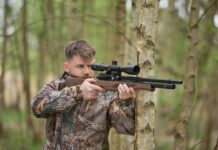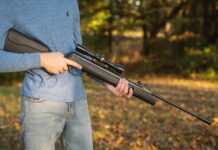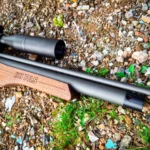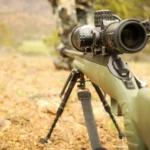Painting your goose decoys can be done with a few supplies and a little learning.
Let me make this SUPER easy for you to do by following my step-by-step directions on how to paint goose decoys.
Many people have used these instructions to make decoys that looked like they should have been thrown away to look brand new and ready to hunt over once again.
Table of Contents
- Supplies Needed
- Setting Up Your Painting Area
- Using Masking Tape To Protect Areas
- What Type Of Colors Should You Pick?
- What Type Of Pattern Should You Go For?
- Is There A Color Difference In Geese Based On Gender?
- How To Apply The Paint
- Spray
- Brush
- How Long Should The Paint Dry?
- How Long Before You Can Deploy The Decoy To The Field?
- Will Geese Be Able To Tell The Difference Based On Smell?
- Should You Apply Coatings To Make Your Paint Last Longer?
Supplies Needed
- Earth brown flat non-reflective spray paint
- Khaki flat non-reflective spray paint
- Black flat non-reflective spray paint
- Black Flat oil based paint
- White Flat oil based paint
- Small paint brush
- Painters tape/masking tape
- Box cutter/knife
- Disposable/plastic gloves (optional)
Step 1: Clean and dry the decoys.
Step 2: Apply painter’s tape/masking tape covering the white tail feather area.
Step 3-11: Instantly download/view my complete FREE step-by-step instructions by clicking the button below.
Setting Up Your Painting Area
When it comes to prepping your workstation for your decoys, you should choose a space in the home that is free of traffic. Paint fumes can also be hazardous, so ensure the room or area has enough ventilation.
This will ensure that you are not disturbed throughout the process. You can set up your station on a big enough table and place some newspaper or material down so that you don’t stain your table.
Ensure that the tape is big enough to place your decoys, paint cans, brushes, and any other tools you are using for painting and that you have all of your tools on hand before beginning the process.
Also, ensure that the area is free of any dust and debris that could be get stuck to the paint and affect the finish on the painted decoys.
Using Masking Tape To Protect Areas
Masking tape is going to come in extremely handy in this process. The masking tape will be used to cover the right side feather area, the whitetail feather area as well as the white ring around the decoy neck.
Start by applying a 1/4 inch masking tape covering these three areas after you have cleaned and dried the decoys, but before you begin painting.
What Type Of Colors Should You Pick?
When it comes to painting a goose decoy, you should note that a goose can be any color from completely gray to completely white.
Male geese are also born with bright orange beaks, and the females have a brown beaks. As both of the sexes mature, the males will grow white feathers and keep the orange beak, and the females will grow gray feathers, and the beak will also change to orange.
So when it comes to choosing the colors for your decoys, bear this information in mind.
What Type Of Pattern Should You Go For?
When it comes to painting your goose decoys, you want them to look as realistic as possible. So this is the time that you need to make reference to the photo that you are referencing to paint decoys.
You want to add details to make them look realistic as well, and if the chest feathers are a different color than the body, then you need to use that specific color of paint across the chest at this time.
Ultimately, try to stick to the details of real geese and ensure that they look natural and realistic as much as you can. Although you may want to add some of your own creativity, if it means taking away from the realism of your decoy, then don’t do it.
Is There A Color Difference In Geese Based On Gender?
In most breeds, both the male and female geese look alike. So it’s quite difficult to tell them apart. In most cases, though, the goose is darker than the gander.
This is even evident when they are still quite small, and as they grow, most geese will resemble the Toulouse color while the gander will resemble the Emden.
How To Apply The Paint
When it comes down to deciding whether to spray paint your decoy or paint it with a brush, it all boils down to personal preference.
While some people may find it easier to spray-paint their decoys, others believe that they get more accuracy out of a paintbrush.
The good news is that there is no rule that says that you need to use either one or the other, and you can choose to use both.
When it comes to coloring larger areas of the goose, a spray can do the trick. However, when it comes to adding detail and painting areas such as the tail, feathers, or beak, using a specific-size paintbrush will give you more detail and accuracy.
Spray
Spray cans can be used for larger areas.
Brush
A paintbrush will help you achieve more detail.
How Long Should The Paint Dry?
If you are applying a primer, you should allow it to dry for approximately 20 minutes before adding paint. When painting, allow the paint 10 to 20 minutes of drying time is required before you apply another coat.
If you are using spray paint, then it’s going to dry quicker, and you’ll need approximately 10 minutes in order for it to dry completely.
When it comes to painting the beak, it is recommended that you use acrylic paint and allow it to dry for 10 minutes before applying any additional coats.
How Long Before You Can Deploy The Decoy To The Field?
Depending on whether you are using spray paint or paintbrushes to finish off your decoys, it can take anywhere between 1 to 3 hours before you use it.
So once you’ve completed painting the decoy, set it on a flat surface so it can dry consistently.
You should check on it 2 to 3 hours later, and if the paint is completely dry, then you are ready to set your decoy out in the woods and use it as you please.
Will Geese Be Able To Tell The Difference Based On Smell?
When it comes to painting your goose decoys, you should do it well in advance. This will give the paint enough time to dry thoroughly and also get the smell of paint fumes off the decoys.
However, as long as the decoys look realistic, that is no reason why geese will not commit.
Should You Apply Coatings To Make Your Paint Last Longer?
Yes, there is no rule that says that you cannot use extra coats of paint on your decoys to ensure that the paint lasts longer. However, it is recommended that you only purchase a satin finish, latex paint.
This is because satin-finish does not contain any type of gloss and is the right sheen for painting decoys.
Ultimately, if you invest in any type of paint or say a high gloss paint, it’s going to make your decoys look shiny, and unless you’ve seen a shiny goose, this is sure to make other geese flare instead of committing.
So if you want to avoid this from happening, ensure that the paint you use on your decoys looks as natural to the real thing as possible.
You Might Also Read: Duck Hunting Decoy Tips











































